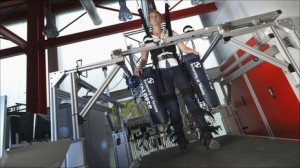The “Robot Legs,” LOPES
Dutch scientists have came up with the invention of robotic legs for stroke patients. LOPES, or the Lower-extremity Powered ExoSkeleton, helps improve the movement of the legs and for the patients to recover their natural steps. Spinal injury patients who have restricted movements have been given test trials. This device may be released to rehabilitation centres across different countries next year.
Engineers from the University of Twente in Enschede, Netherlands, developed this device to help and support the patients while on treadmill in rehabilitation centre. The machine operates by either walking for the patient or by assisting support on either side of the patients’ legs. Furthermore, if the patient is not moving right, LOPES can also detect their mistakes.
One of the testers of this device, Petra Hes, has what is known as “drop foot.” She has suffered a stroke at a very young age that caused her not being able to lift up or flex her left foot. Dr. Edwin van Asseldonk, a worker on the project, explained how LOPES is able to compare the patients’ movements to a reference and helps the patients by applying a force on them.
The forces exerted on the patients’ legs will physically guide the movement of the legs and feet. Researchers believe the machine acts as a memory aid to the patients who have forgotten how to move. The result with Hes has been turning out positively. By exerting the force on the patients, hence, LOPES aids the required signals in the brain to further regulate the movement.
Having such an innovation will help those who have suffered from strokes or those with impaired physical movement. Devices like these enable people to recover and start walking just as they used to! They are being tested in Netherlands before being released to clinics worldwide.
Furthermore, there are similar inventions called “Military Exoskeletons” used in the military to help lift heavy loads. Human Universal Load Carrier (HULC) is designed by Berkeley Bionics of California. Soldiers can as much weight as 90kg. HULC is strapped around the soldier’s body and has been used by US Military.
Further Reading:
News Article Source: BBC News




September 28th, 2011 at 3:43 pm
Very interesting! On their project web site it has a neat timeline of how the project has progressed starting in 2001: http://www.bw.ctw.utwente.nl/research/projects/lopes.doc/index.html
They have made incredible progress!
November 10th, 2011 at 9:36 pm
I like how this robot is made with the intention of rehabilitation, so the patient is not going to stay completely dependent on the robot.
I blogged about another robotic leg research with a very similar approach. It’s reassuring to find there are multiple groups supporting this line of thought!